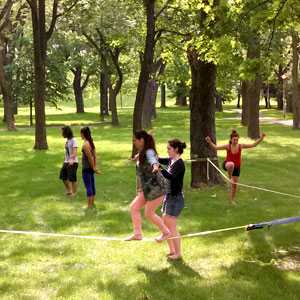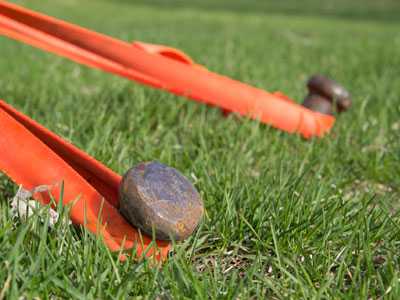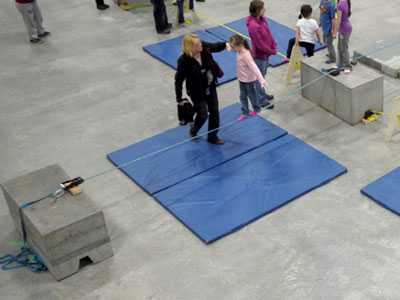
FAQ
General information
Slacklining is a dynamic balance training. It works out the body and the mind in a very specific and efficient way. A slackline is a piece of nylon or polyester webbing (generally speaking) tensioned between two trees or other solid anchors.
The main goal is to stand, walk or do tricks in balance on the line. Anyone can develop their own style of slacklining and create a unique way of training.
![]()
There is no direct link between slackline and the circus. Even though it does look like tightrope and was probably inspired by it, slacklining was actually developed by rock climbers in the early 1980's, in Yosemite National Park, in California.
The main difference between a tightrope and a slackline is the use of dynamic material. Because the webbing is flexible, there is more movement in the line, which makes it a bit more challenging to balance on it, but allows one to perform a variety of figures. Also, because webbing is way lighter than steel cables, you can carry it around and set it up easily, which makes it more accessible.
Slacklining is definitely a really fun and accessible way of training the body and mind.
First of all, it requires the use of stabilizer muscles from the entire body. Training those muscles makes everyday tasks like walking, standing or going up the stairs much more stable and easy, making one feel stronger, more endurant and definitely more balanced. Working out stabilizer muscles can also help prevent injuries by reinforcing support of the joints and improving posture.
Mentally, slackline teaches one to stay focused, concentrate for long periods of time and let go of thoughts. It can help become more calm, relaxed and confident. It is a form of active meditation.
![]()
Slacklining is accepted almost everywhere, but it is good to be aware of this one law for public spaces in Montreal.
« It is forbidden to use urban furnitures for any purpose other than that to which it is intended, to degrade or make any changes to them whatsoever. 99-102, a. 20. »
To keep the practice safe and accepted, please follow these guidelines:
- Make sure your line is visible at all times and does not cross any trail or bike path.
- Do not leave your line unattended in a public space.
- Always protect the trees by using adequate padding between your line and the bark of the tree. Also use trees with a diameter of more than 12" and avoid soft bark, damaged trees or unsafe anchors like lamp posts.
- Make sure your equipment is in good condition and use proper rigging techniques. Remember that you are responsible for your line.
- Be respectful of the environment and the area you practice in. Lets make sure slacklining keeps a good reputation.
Even though any sport can be risky at times, slacklining is a very safe activity when practiced properly. Very few incidents have been reported so far. To keep the practice safe and accepted, please follow these guidelines:
- Make sure your line is visible at all times and does not cross any trail or bike path.
- Do not leave your line unattended in a public space.
- Always protect the trees by using adequate padding between your line and the bark of the tree. Also use trees with a diameter of more than 12" and avoid soft bark, damaged trees or unsafe anchors like lamp posts.
- Make sure your equipment is in good condition and use proper rigging techniques. Remember that you are responsible for your line.
- Be respectful of the environment and the area you practice in. Lets make sure slacklining keeps a good reputation.
Yes. Slackline Montreal offers slackline group classes, private training and workshops all year round. Have a look at the services section for more information.
![]()
Technical information
To keep slacklining safe and accepted, please follow these guidelines:
- Make sure your line is visible at all times and does not cross any trail or bike path.
- Do not leave your line unattended in a public space.
- Always protect the trees by using adequate padding between your line and the bark of the tree. Also use trees with a diameter of more than 12" and avoid soft bark, damaged trees or unsafe anchors like lamp posts.
- Make sure your equipment is in good condition and use proper rigging techniques. Remember that you are responsible for your line.
- Be respectful of the environment and the area you practice in. Lets make sure slacklining keeps a good reputation.
We use different names to describe slacklines depending on their lenght, height and tension.
Trickline
Tricklines are tighter lines on which one can perform jumps and aerial figures. They are usually shorter than 100' and tightened with pulleys or ratchets.
![]()
Rodeoline
Rodeolines have high anchor points and no tension, creating a "U" shape. They are really easy to install and require minimal equipment, but can be extremly challenging. A greater sag (height difference between the anchor points and the person standing on the line) and a longer distance will increase the level of difficulty.
![]()
Longline
Longlines are usually over 150' long. In general, the longer the line is, the harder it gets. The current world record for the longest line is 1650' (500m) and was established by Jerry Misjewski in 2011. Longlines can be pretty high off the ground in order to avoid having the line touch in the middle. They must be tensioned with really efficient pulley systems.
![]()
Highline
Highlines have to be at least 20' high in order for the practitionner to wear a harness and a safety rope called a "leash". They represent the most advanced type of slacklines and require an incredible amount of focus, confidence and strenght. Often times, people think highliners are adrenaline junkies, but the practice of highlining is actually highly meditative and can help one develop calmness and fearlessness. It is important to understand that rigging highlines is a real art and requires serious knowledge and practice. Do not attempt to rig a highline without the presence of a professionnal rigger.
![]()
There are 3 main systems used to put tension on a webbbing:
The traditionnal carabiner system
Rodeolines have high anchor points and no tension, creating a "U" shape. They are really easy to install and require minimal equipment, but can be extremly challenging. A greater sag (height difference between the anchor points and the person standing on the line) and a longer distance will increase the level of difficulty.
![]()
The ratchet system
The ratchet is a cheap and efficient way to tighten a slackline. It is mostly used with 2" webbing but it is also possible to find 1" webbing that can work with the ratchet. The only limitation of this system is that it does not allow the use of flexible webbing (10% stretch or more). Therefore, it is mostly used to setup tighter and more rigid lines called "tricklines" on which people perform aerial figures.
![]()
The pulley system
Pulleys are mostly used to tension tricklines, longlines or highlines because they allow one to apply more tension and to control more precisely the amount of tension being pulled. They represent a greater investment but are essential to any serious slackliner.
![]()
Trees
Trees are usually the most convinient anchors. We recommand trees with a diameter greater than 12" (depending on the type of line you want to rig). If you notice that the tree is moving a lot when you're practicing, it could be a sign that you should use a bigger tree. Avoid soft bark or damaged trees.
Watch the tutorial for a traditionnal slackline![]()
Colomns
Before you use colomns to setup a slackline, make sure they are solid enough. Most colomns are designed to support vertical weight and not horizontal tension. Contacting an ingineer can be a good investment if you're not 100% sure about the resistance of the colomns.
![]()
Posts
Replace trees by inserting a metal post or wooden beam at least 5' into the ground. It can be necessary to solidify your post with concrete depending on the height at which you expect to rig your line.
![]()
Stakes and A-frames
You can also use different types of steel stakes into the ground to create a removable anchor. Then, use A-frames to elevate the slackline at desired height. Visit our <a href="/en/products">products</a> section to find our stakes and A-frames kit.
Watch our instructionnal video here.![]()
Gymnasiums
Slackline Montreal has developed adaptors that can easily be inserted in badminton or volleyball post holes to quickly create slackline anchors. Visit our <a href="/en/products">products</a> section to find our complete kit for gymnasiums.
![]()
Concrete blocs
You can use concrete blocs in different ways to rig slacklines. Attach directly to the steel handles if they are in good condition or wrap the bloc with a spanset and use A-frames to elevate the line to the desired height. You can also burry the concrete bloc in the ground or pour concrete underground to create a more permanant anchor.
![]()
"Dead man" anchors
The deadman anchor is usefull in sand, snow or any kind of soft ground.
Click here for an instructional video![]()
Wooden floors
To create an anchor on a wooden floor, drill a hole right through a support beam and place an eye bolt through the hole. Secure the bolt on the other side of the beam with a washer and a nut. To ensure a safe installation, contact an ingineer.
![]()
Concrete floors and rock
It is possible to find bolts that are specifically designed for rock or concrete. To find the right type of bolt and ensure a safe installation, contact a professionnal.
![]()
Portable slackline rack
For a more portable solution which doesn't required drilling holes or making a big mess, use a slackline rack. Rent our portable structure for a special project or build your own. Otherwise, the <a href="http://www.gibbon-slacklines.com/en/products/slackline-structures/slack-rack-300/index" target="_blank">slackrack</a> from Gibbon can be a great solution for the house.
See our portable rack in this video![]()
Yes. If you like winter and cold weather, have fun in the snow.
![]()
If you're a beginner, you should keep your line relatively low (below hips height) and short (between 15' and 25'). To know if there is enough tension in the line when you set it up, stand or sit in the middle of it and see if it reaches the ground. The rest is up to you. Everyone has his own preferences.
Change your webbing when you start to notice important tears in it or when it has lost most of its elasticity. Your carabiners should last a little longer. Change them if they get stuck often, if you drop them on a hard surface or after 5 years of usage.
Put your dirty piece of webbing in a bath with warm water and <strong>no soap</strong>. Soak it and shake it for a few minutes and then change the water. Repeat the same procedure a couple more times until the webbing is clean.
It is recommended to take your line down after every usage. Otherwise, your equipement might get weaker and break prematurely, especially if the line is outside.




















